Florence
Church of Santa Croce
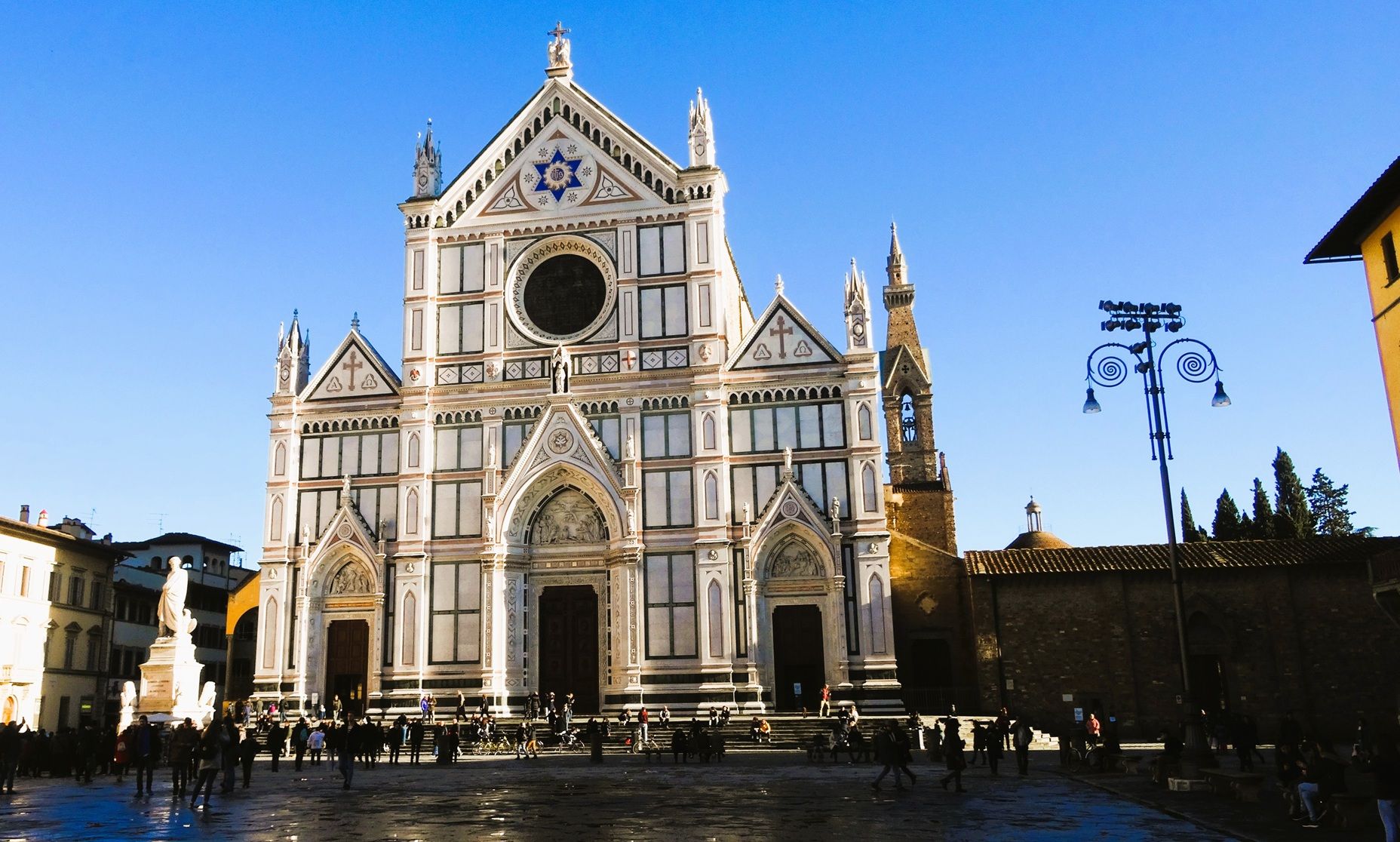
Summary
The Church of the Holy Cross, or Basilica di Santa Croce is the principal Franciscan church in Florence. Dating back to 1212 when St Francis of Assisi visited Florence, a church has existed on the site. The current church was begun in 1296 and incorporates a number of other buildings in the complex situated about 800 meters from the Duomo. The church is most famous as being the burial place for many of the most famous and notable people connected to Florence and is known as “The Temple of Italian Glories” due to the number of famous people commemorated or buried there in elaborately carved and decorated tombs.
|
A masterpiece of neo-Gothic architecture and one of the most important churches in Florence, the Basilica of the Holy Cross holds significant historical, artistic, and cultural value. Situated approximately 800 meters from the Duomo, in the Piazza Santa Croce, a lively square surrounded by historical buildings, shops, and restaurants, the Basilica of the Holy Cross, or the Basilica di Santa Croce, dates to the 15th century, when it was constructed on marshland outside the city walls. A previous structure had been built on the same site, dating from 1212, which legend says was founded by St. Francis of Assisi himself during a visit to the city. The stone layout of the original church was found in 1966 after the terrible flood of that year.
The work on the new church, built by Franciscans, began in May of 1294 on the site of the previous church. This new construction began in the apse and was carried out while the existing church was still functioning. The building seen today was consecrated in 1442, although it had been in use since before 1320.
In the 14th century, the sacristy, infirmary, dormitory, guest quarters, library, and convent were incorporated into the church. In 1423, the dormitory, part of the library, and part of the convent had to be rebuilt after being destroyed by fire.
The church’s construction was subject to several problems. In 1504, public funding for the building ended, resulting in work being suspended, particularly on the building’s façade and bell tower. Eventually work continued because of the generosity of the Spinelli, Pazzi, and Medici families (who produced their own chapels inside the church), as well as contributions made by the public.
In the mid-16th century, the choir in the central nave, which stood in front of the main altar, was demolished which resulted in the destruction of original frescoes and works of art. Large altars were constructed along both side aisles after this demolition.
There were problems with the construction of the marble façade, as it was started at the end of the 15th century but a disagreement between the church and the financier led to the work being halted. The matter was not resolved until the 19th century when construction in the neo-Gothic style began. This work was carried out between 1857 to 1863, using polychrome marble combining white Carrara, green Prato, and pink Siena marble. This was paid for by the English benefactor, Sir Francis Sloane. The façade was designed by the architect Niccolo Matas but, as he was Jewish, he was not buried inside the church but under the threshold.
The marble Façade, arranged in elaborate patterns, includes decorative elements like pointed arches and rose windows. A prominent star of David near the top pays tribute to Matas. The façade also incorporates pointed arches and other Gothic motifs, creating a dramatic vertical effect.
.JPG?876)
The exterior is adorned with statues of saints and religious figures, each carefully crafted to convey spiritual significance. Among these, the statue of Dante Alighieri in the Piazza Santa Croce is particularly notable. Unveiled in 1865 to commemorate the 600th anniversary of Dante's birth, this marble sculpture symbolizes Florence's reverence for the poet.
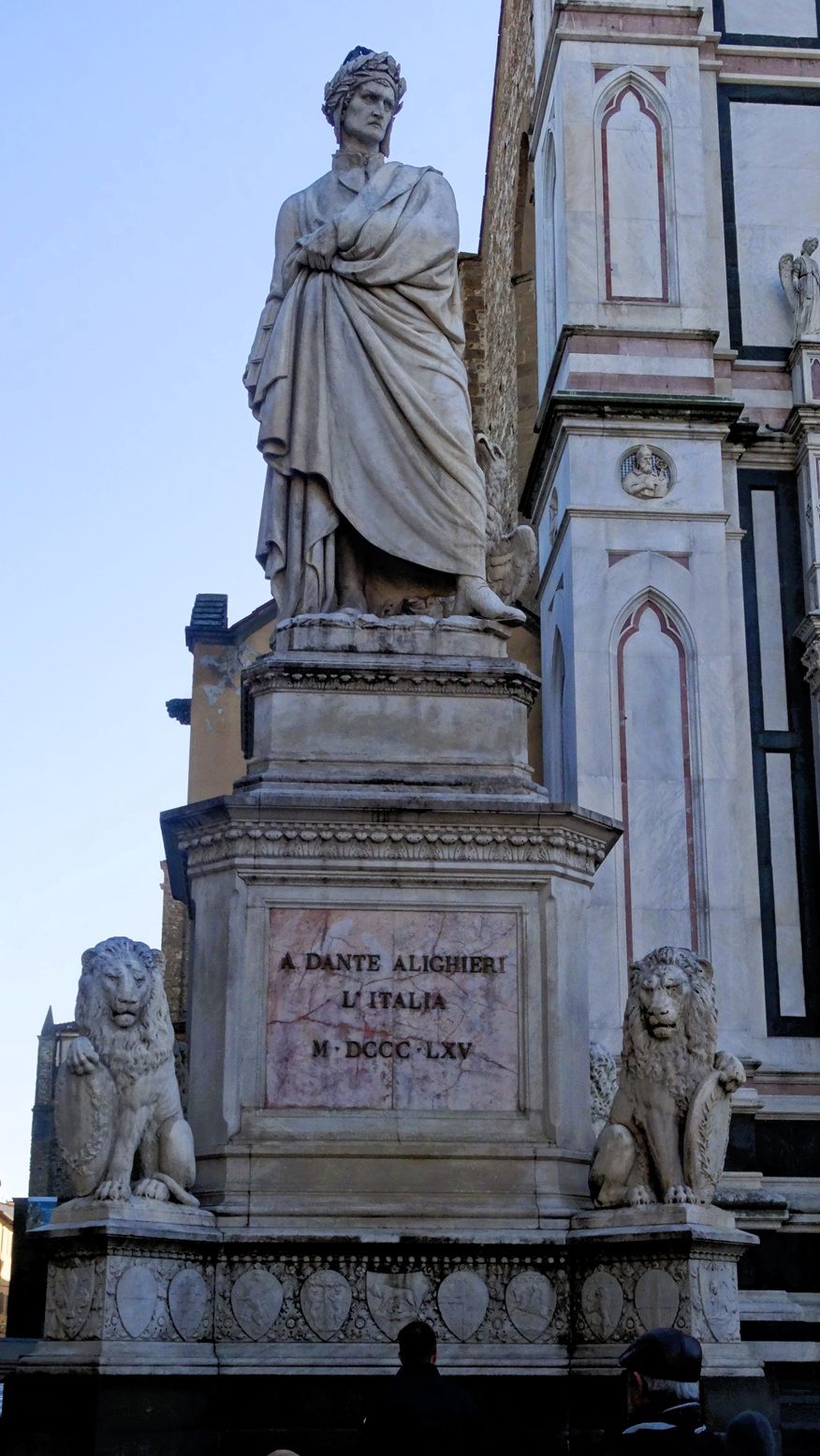
The main entrance of Santa Croce is grand and inviting. The portico has elaborately decorated wooden doors which came from the Duomo of Florence when that was fitted with its current bronze doors. The doors are framed by carved reliefs that depict religious themes, adding artistic depth to the architectural details. The reliefs are accompanied by symbols of faith, such as crosses and floral patterns, that enhance the visual appeal.
Inside, the well-lit nave is 115 meters in length with an open-timber painted roof 40 meters high. It is 40 meters wide, with rows of large, widely-spaced octagonal columns.
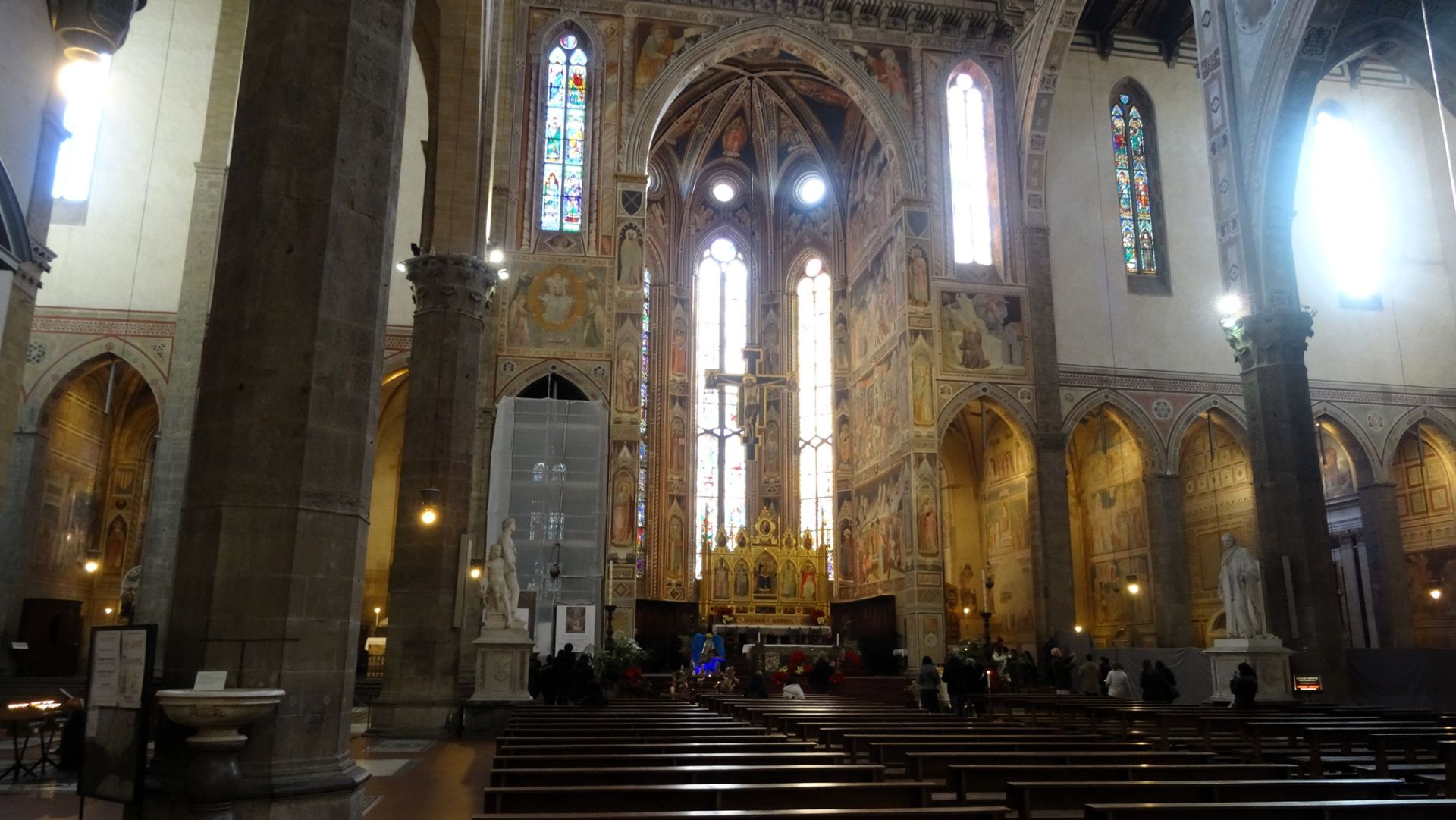
These columns support pointed arches that lead toward the high vaulted ceiling, creating an open and serene atmosphere. The wooden ceiling is painted and intricately decorated, showcasing craftsmanship typical of Florentine Gothic architecture.
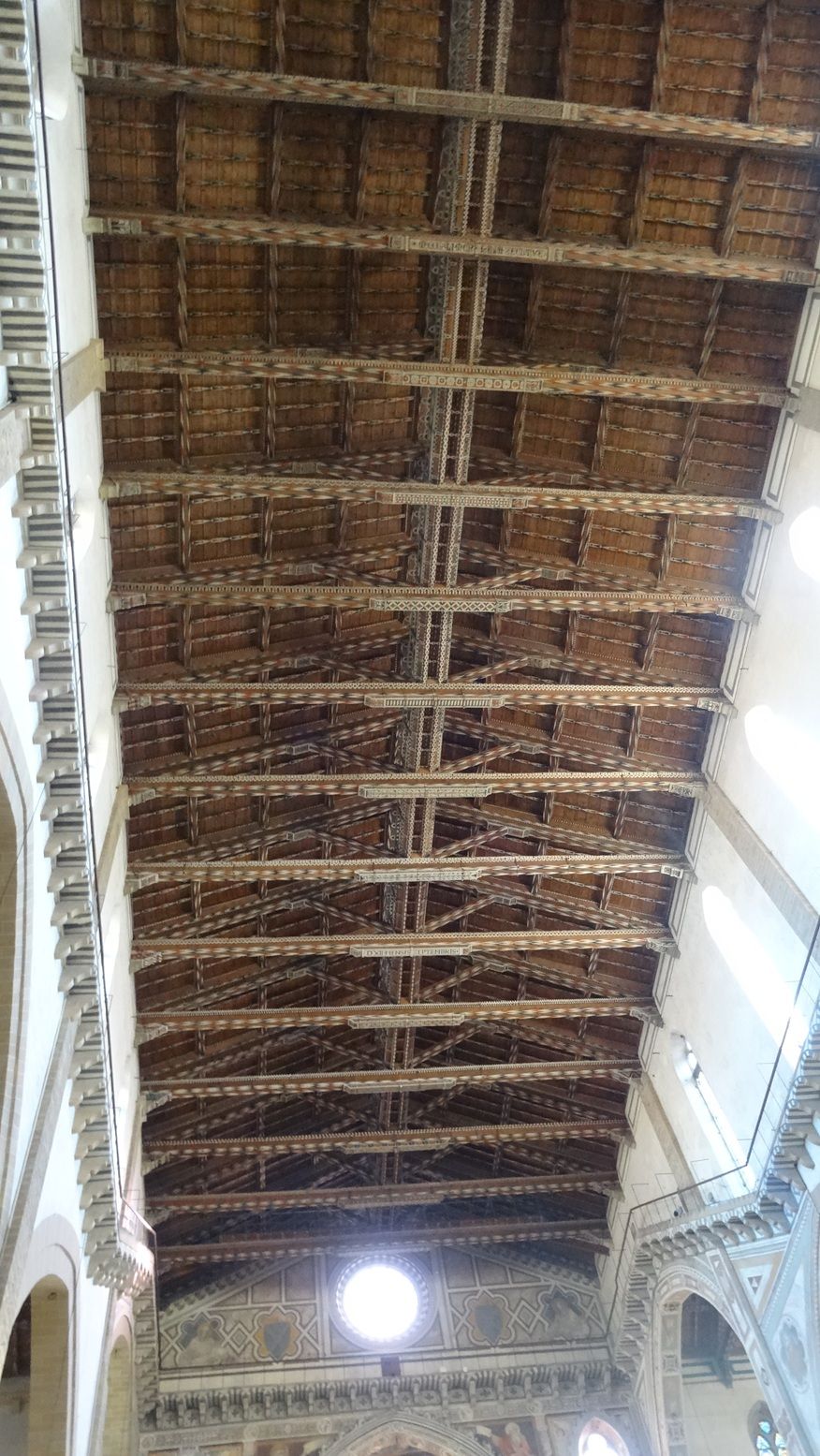
An aisle runs along either side of the nave, the walls are adorned with frescoes that tell biblical stories and commemorate significant moments in Christian history. Along the sides of the nave are altars and chapels, each dedicated to specific saints or patrons. These spaces house beautiful artwork, sculptures, and relics.
Many of the wealthy families of Florence owned chapels in the complex and for 500 years it was a place for notable Italians to have chapels and monuments erected. There are sixteen family chapels, decorated to honour each family, and dedicated by them to one of the saints. Along the side of the aisles is where a number of tombs are located, as Santa Croce serves as the resting place for some of Florence's most celebrated figures, such as Michelangelo, Galileo, and Machiavelli.
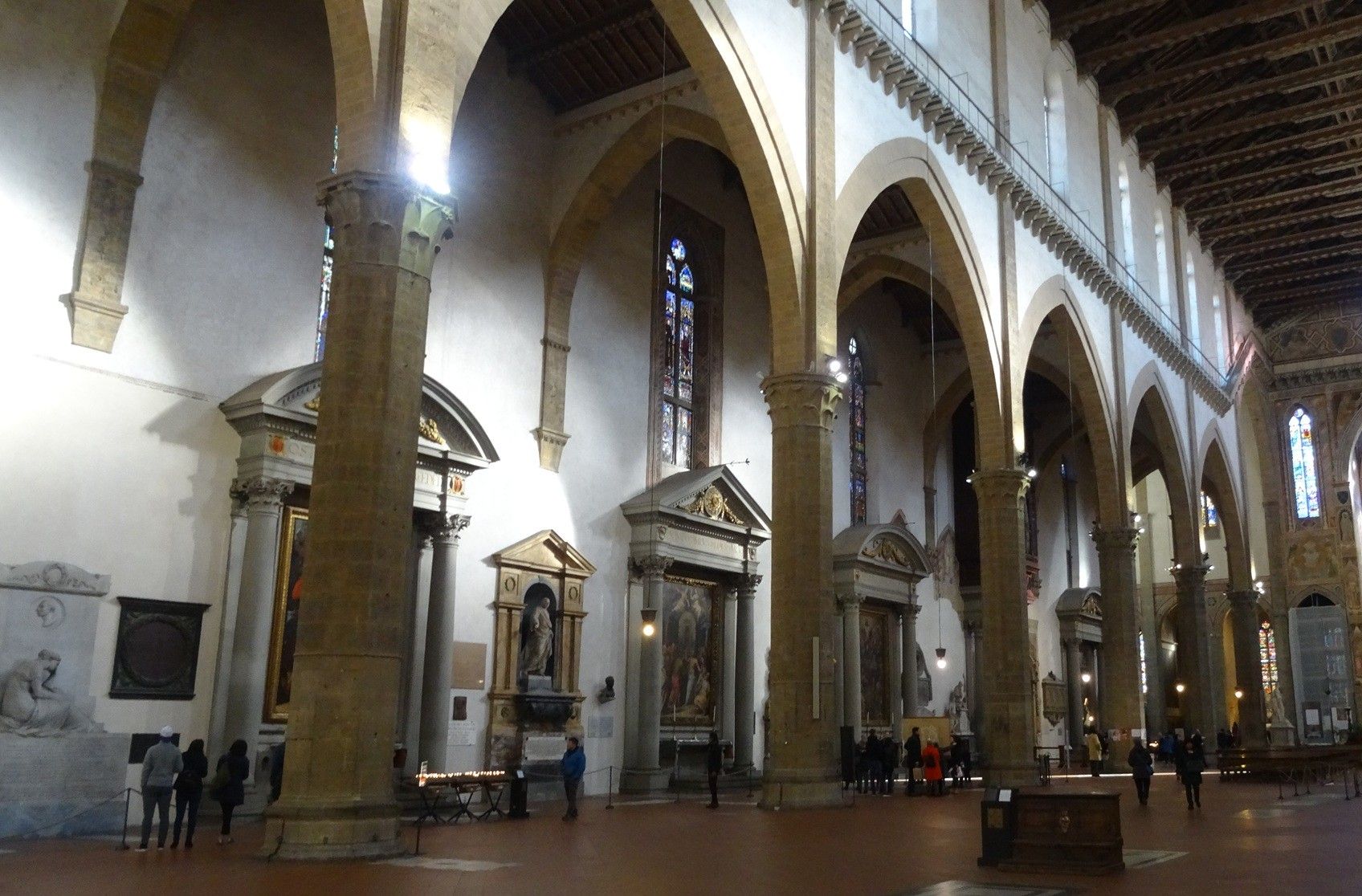
The width of the transept is just over 74 meters. The floor plan is set out as a Tau cross, which is in the shape of a T. Its name comes from the fact that it is shaped like the Greek letter “tau,” which in its upper-case form has the same appearance as Latin and English T, and which is the symbol of St Francis. The floor of the nave is tiled with dark marble and features intricate patterns.
The pulpit in the Basilica is a stunning work of Renaissance art created by Benedetto da Maiano between 1481 and 1487. It is located against the third pier in the south aisle of the basilica. This pentagonal pulpit is made of white Seravezza and red Maremma marble, with intricate gilding, lacquer, and glass inlays. The pulpit features five bas-relief panels that depict episodes from the life of St. Francis.
Beneath these panels are small niches containing allegories of the Virtues, such as Faith, Hope, Charity, Temperance, and Justice. The pulpit's design is both innovative and daring, with steps leading up to it built into the thickness of the pier, requiring structural reinforcement at its base.
This pulpit played a significant role in the church's history, as it was used by friars to preach to the congregation.
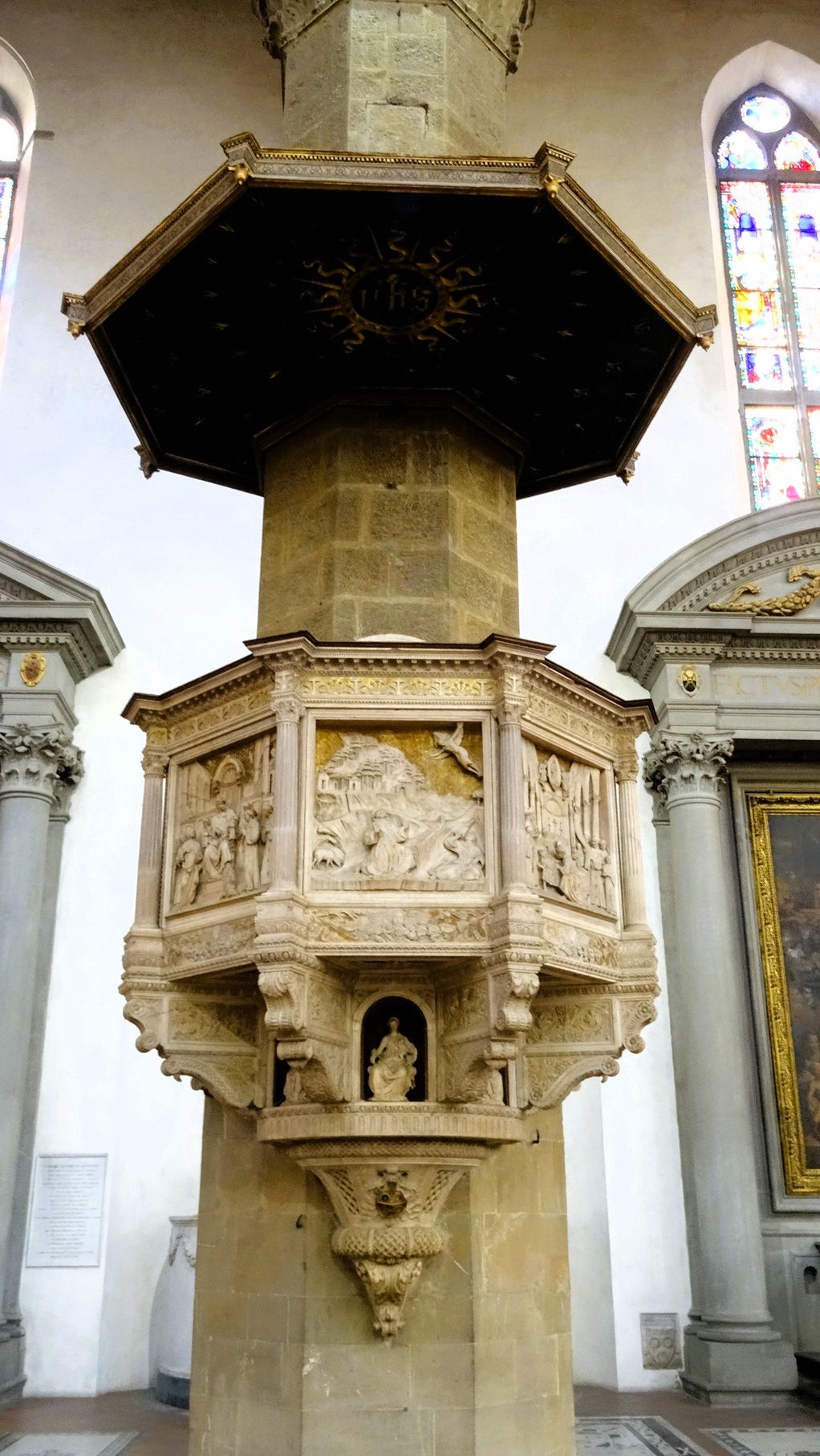
At the far end of the nave is the chancel chapel, rich with artistic and historical significance. It contains stunning stained-glass windows, believed to be crafted by Taddeo Gaddi, a renowned artist and the father of Agnolo Gaddi. These windows allow light to filter through in brilliant hues, enhancing the spiritual and visual experience of the space. The architectural design of the chapel reflects the basilica's overall harmony of Gothic and Renaissance influences.
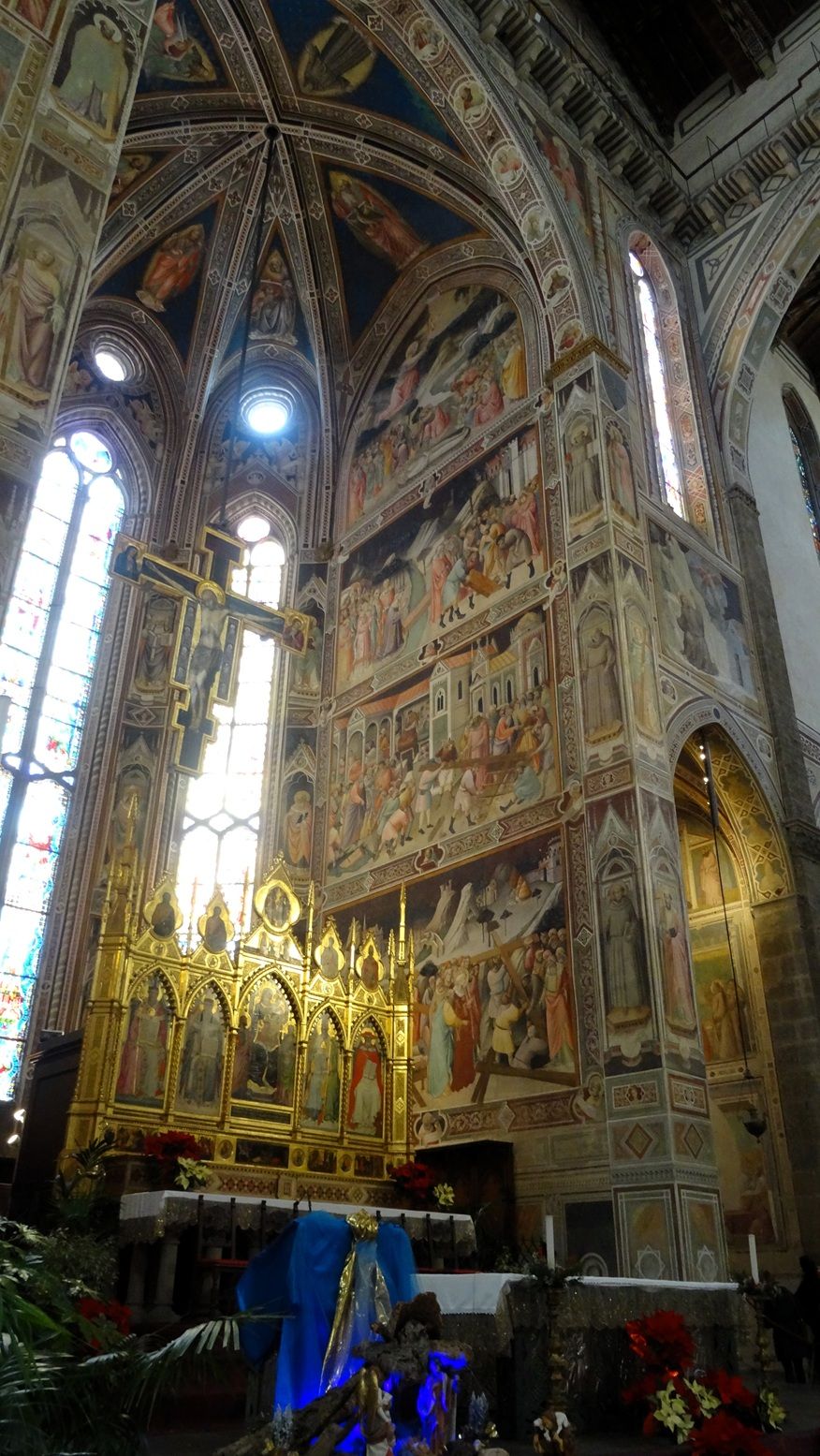
The chancel houses the high altar and features magnificent frescoes painted by Agnolo Gaddi. These frescoes illustrate the "Legend of the True Cross," a story about the wood used to create the Cross of Christ, showcasing Gaddi's mastery of the Late Gothic style. The vivid colours and intricate details make this one of the chapel's most remarkable features.
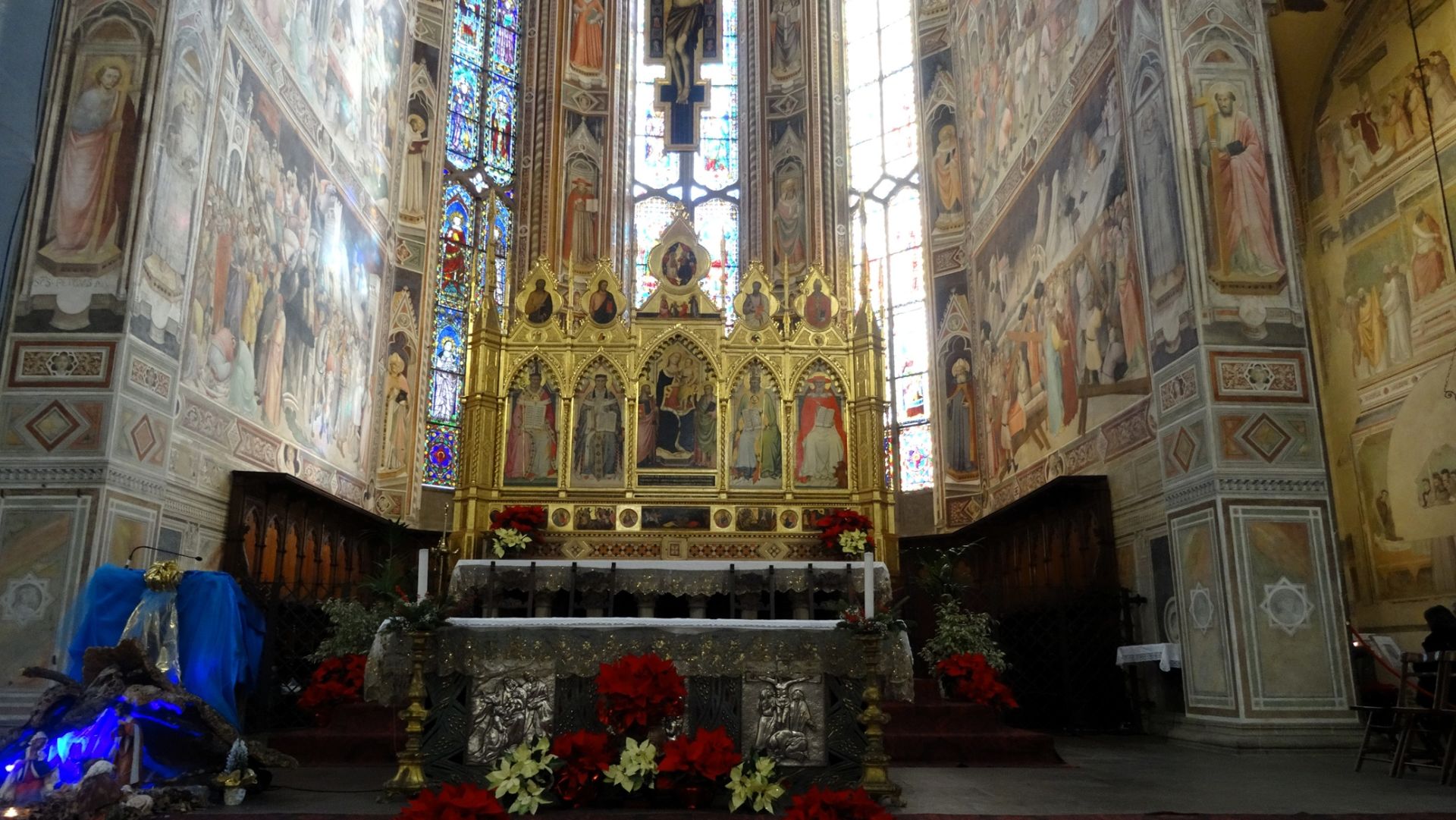
The Basilica is often referred to as the "Temple of the Italian Glories" because it houses the tombs of many illustrious figures. It is the burial place for many of the most famous and notable people connected to Florence. Elaborately carved and decorated tombs fill the interior, and many tombstones cover the floor.
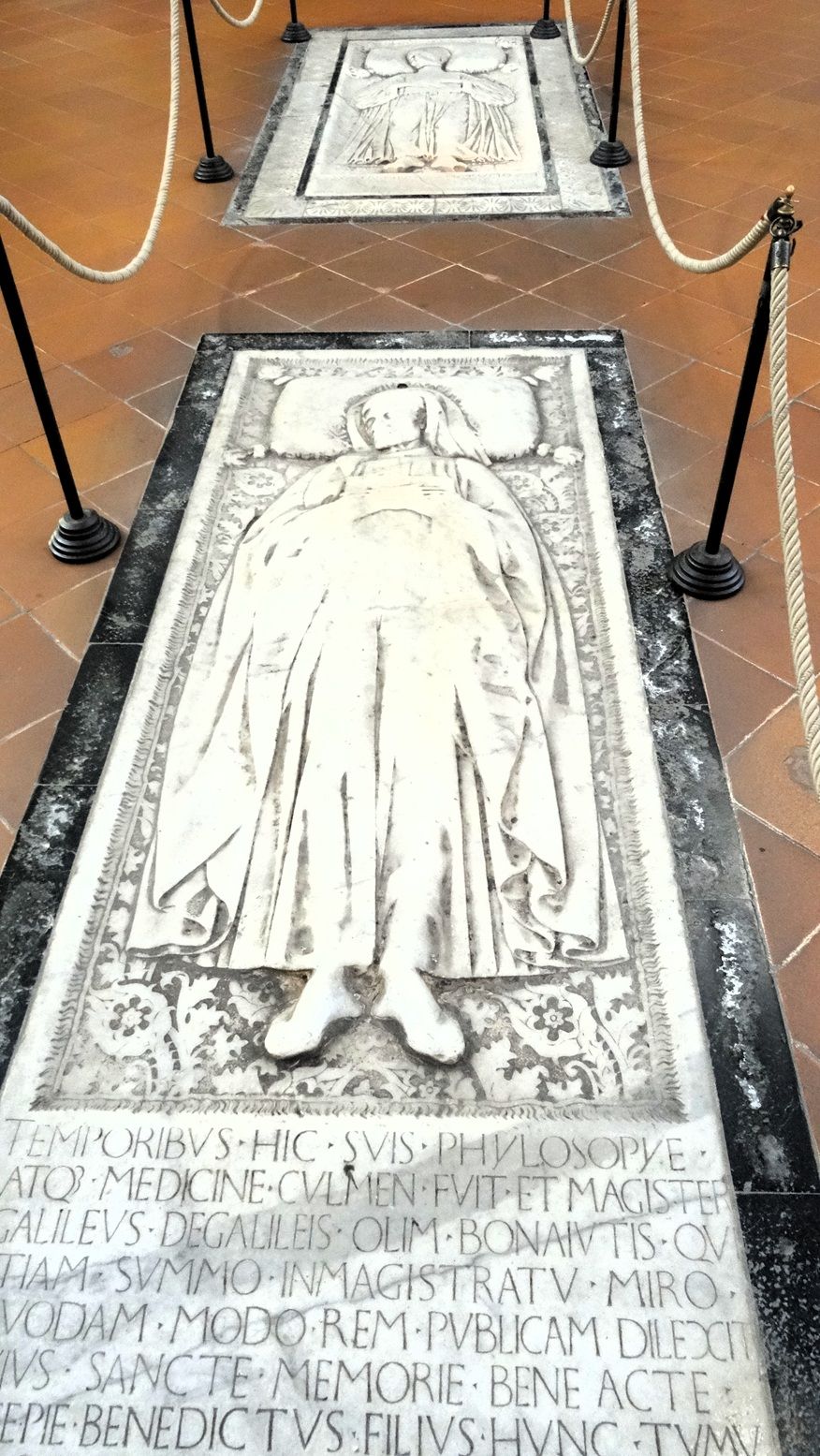
There is a memorial to Dante Alighieri (1265-1321) in the form of a sarcophagus, but it is empty, as he is not buried in the church. Dante was born in Florence but was exiled from the city and died in Ravenna where he was buried.
Although he was born and died in Pisa, Galileo Galilei (1564-1642) is buried in Santa Croce. He was not allowed a Christian burial until 1737, 95 years after his death, due to what the church considered his heretical beliefs. Galileo Galilei's tomb is located in the Basilica of Santa Croce in Florence, Italy. His monumental tomb was designed by Giovanni Battista Foggini and completed in 1737. The tomb features a bust of Galileo holding a telescope, symbolizing his ground breaking contributions to astronomy. Surrounding the sarcophagus are allegorical statues representing Astronomy and Geometry, crafted by Vincenzo Foggini and Girolamo Ticciati, respectively. Interestingly, Galileo was initially buried in a modest grave due to opposition from the Church, as he was condemned for heresy. It wasn't until nearly a century later, with the support of Grand Duke Gian Gastone de' Medici, that his remains were moved to this grand tomb in Santa Croce.
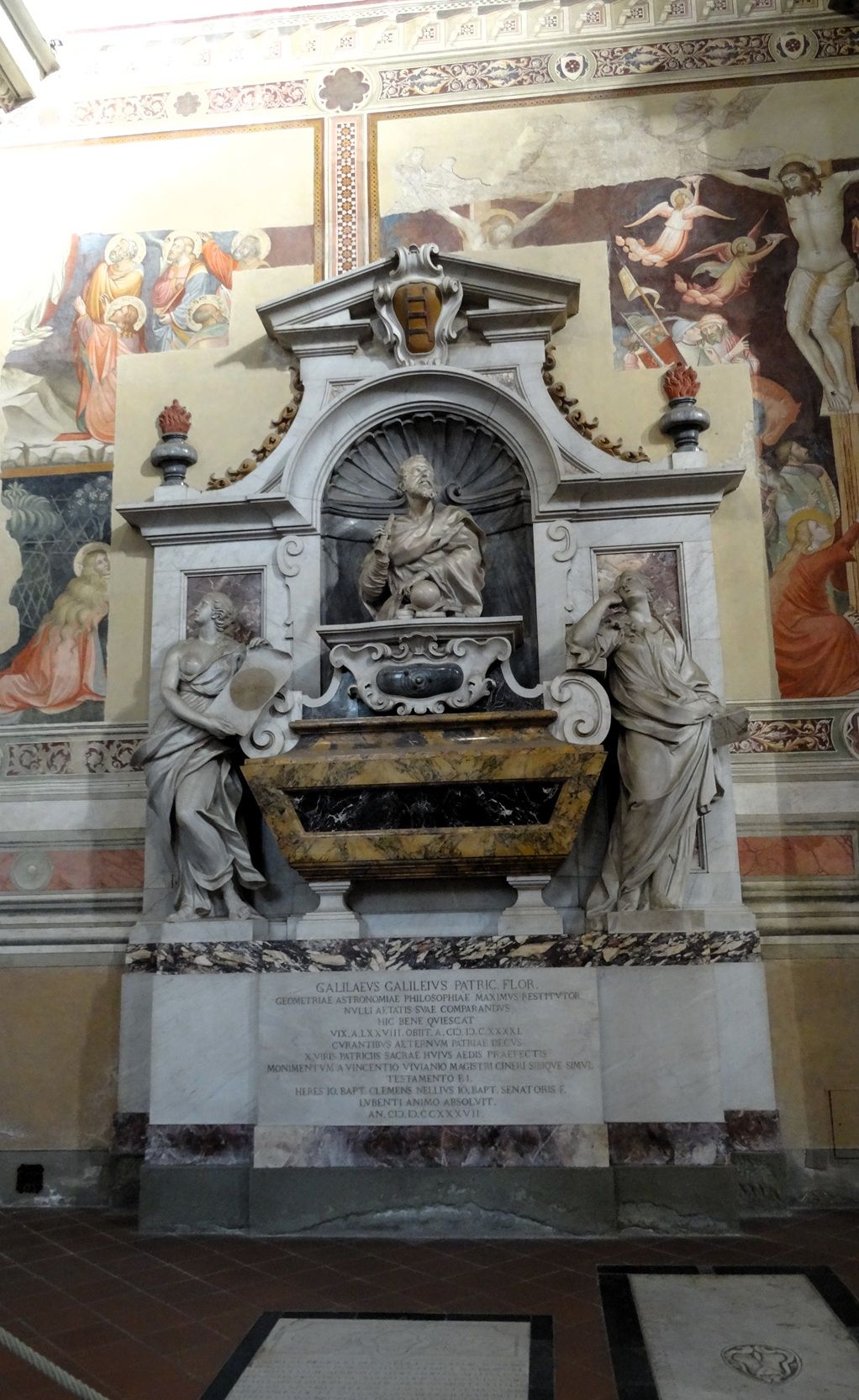
Louise of Stolberg-Gedern (wife of Charles Edward Stuart, 'Bonnie Prince Charlie') is buried in the church, as is the wife of Joseph Bonaparte, Julie Clary, and their daughter Charlotte Napoléone Bonaparte.
Niccolò Machiavelli was an Italian Renaissance political philosopher, diplomat, and historian, best known for his influential work, "The Prince," which discusses political power and strategy. He is often regarded as the father of modern political philosophy and political science.
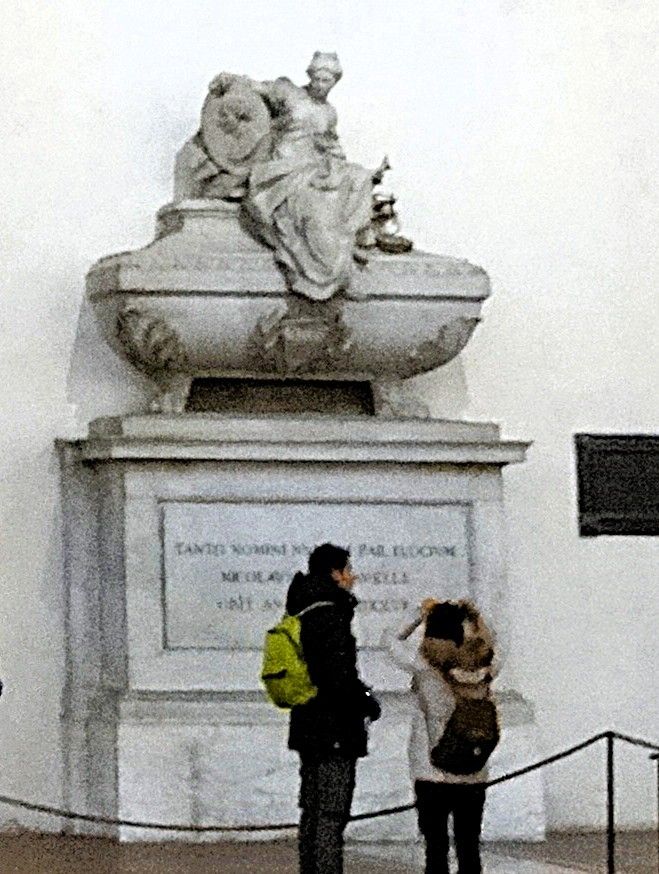
Gioachino Rossini, the renowned composer, is honoured with a monumental tomb in the Basilica of Santa Croce in Florence. His tomb, designed by Giuseppe Cassioli, was completed in 1902. It features a dramatic and artistic design, including a large standing figure of "Music" draped in a sumptuous cloak, mourning at the foot of the sarcophagus. A bust of Rossini is prominently displayed, surrounded by a gold mosaic background, adding a theatrical touch to the monument. Rossini's body was originally buried in Paris at the Père Lachaise Cemetery after his death in 1868. However, in 1887, his remains were moved to Florence, where he was laid to rest among other illustrious Italians in Santa Croce.
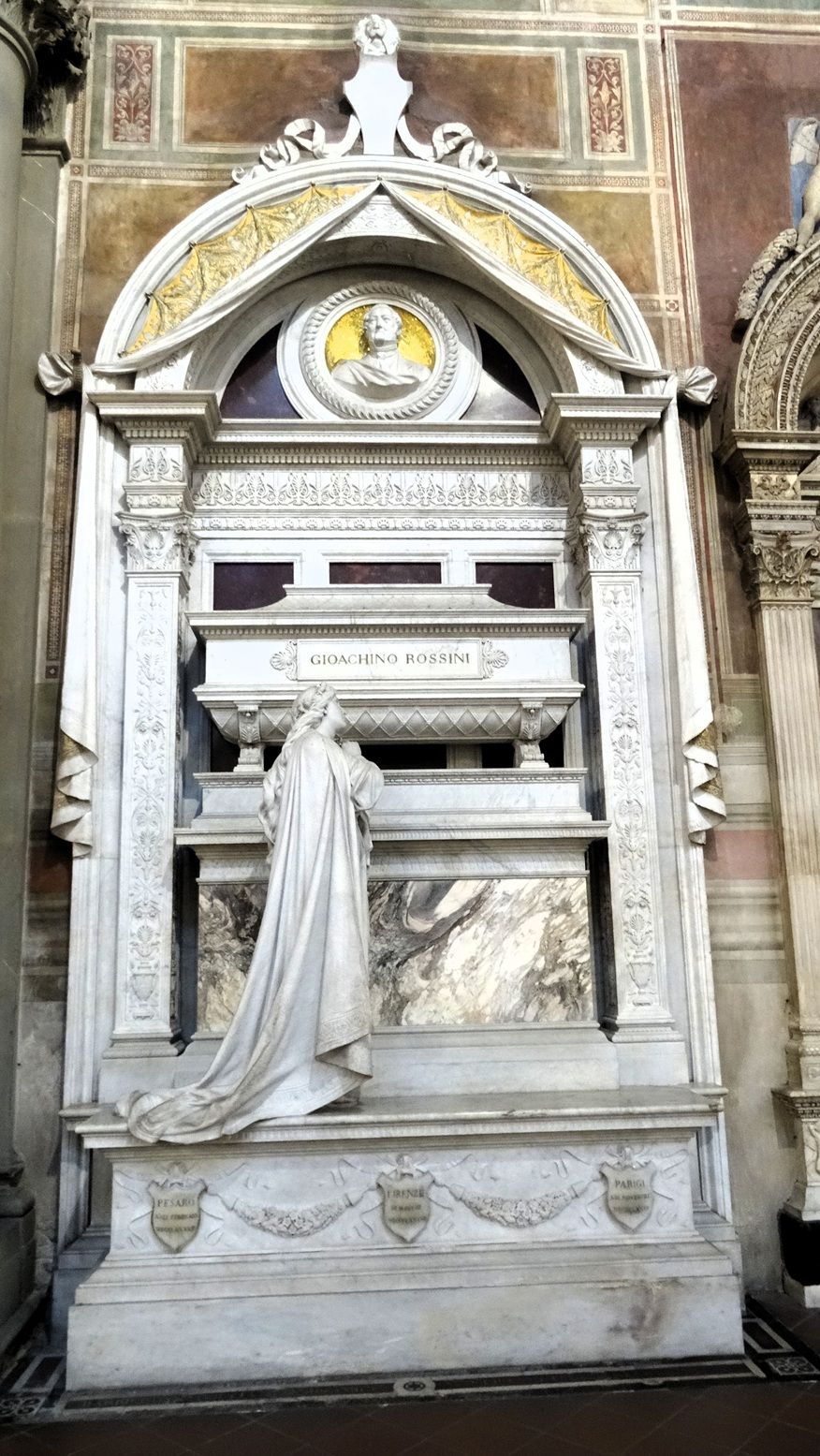
Michelangelo's tomb is was designed by Giorgio Vasari, with the tomb being completed in 1576, over a decade after Michelangelo's death in 1564. It combines elements of painting, sculpture, and architecture. The tomb features a bust of Michelangelo, created by Giovanni Battista Lorenzi, and three allegorical statues representing Painting, Sculpture, and Architecture, symbolizing the fields Michelangelo excelled in. These statues appear mournful, reflecting the loss of the great artist. Michelangelo's body was initially buried in Rome, but his nephew secretly transported it to Florence, fulfilling Michelangelo's wish to be laid to rest in Florence.
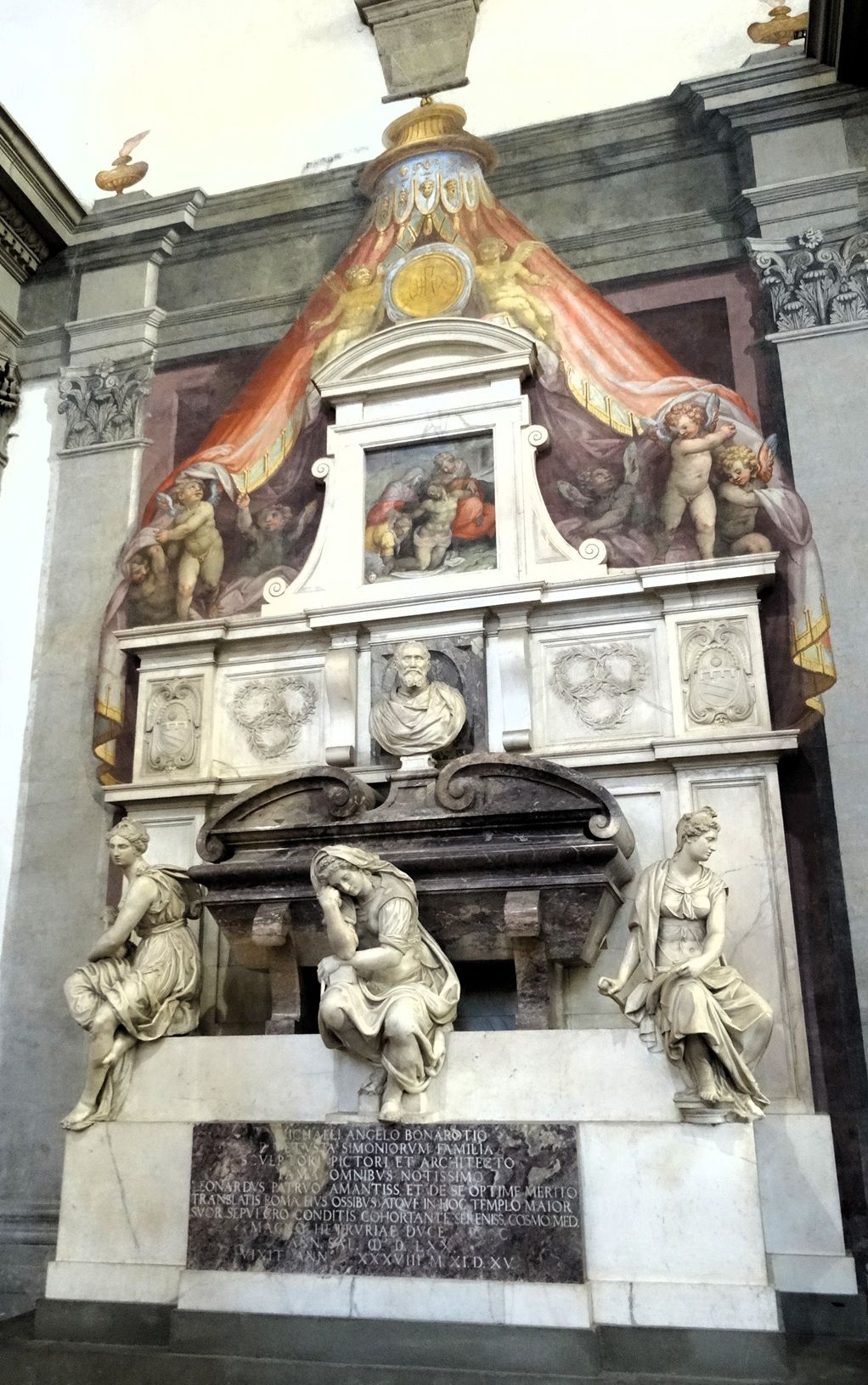
The tomb of Gino Capponi, a prominent Italian historian and statesman, was created in 1884 by the sculptor Ippazio Antonio Bortone. It features a statue of a mourner laying flowers on a sarcophagus, with a portrait bust of Capponi in a medallion above.
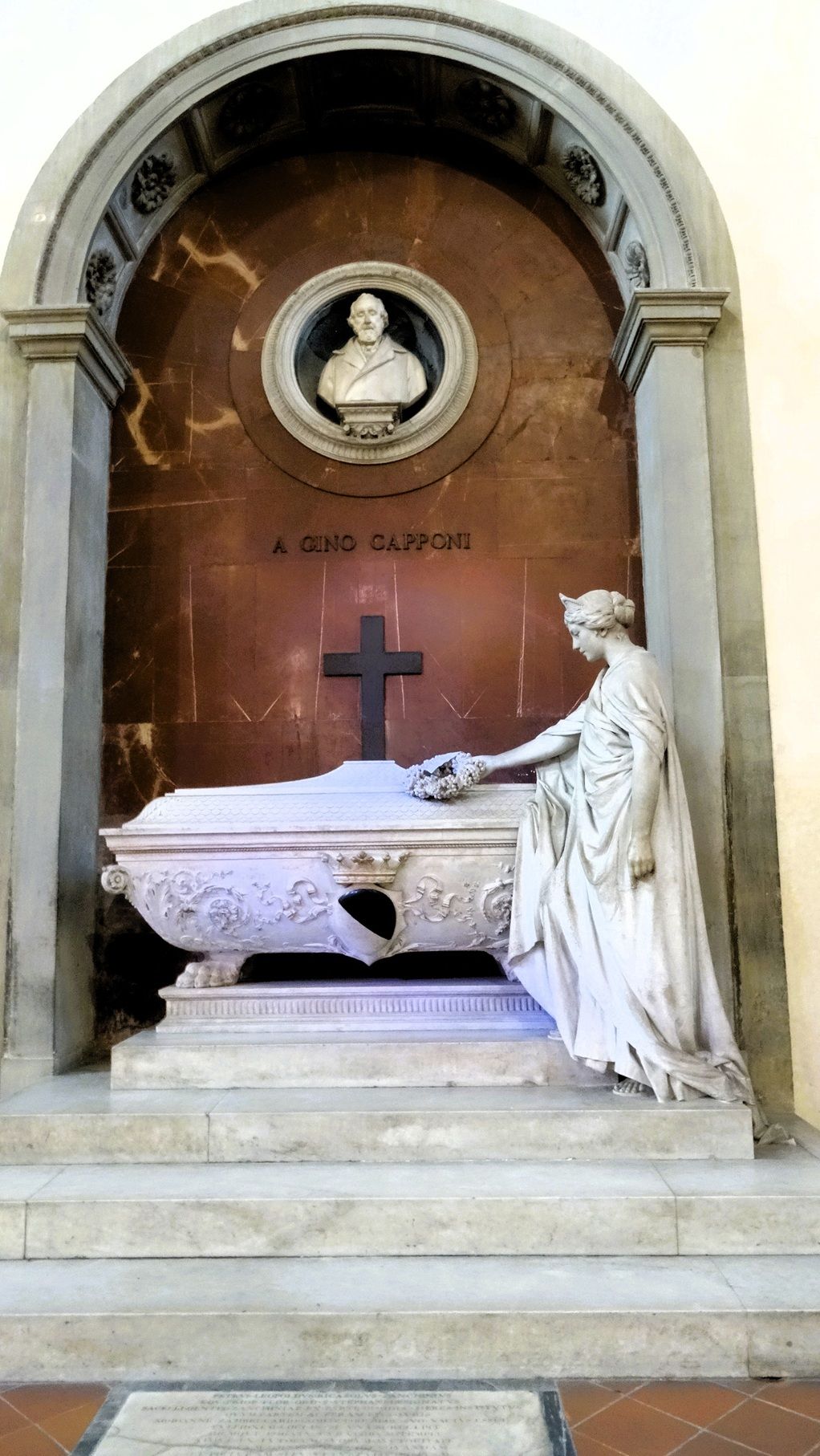
The Tomb of Leonardo Bruni is a masterpiece of Renaissance funerary art which was designed by Bernardo Rossellino between 1445 and 1450. Leonardo Bruni was a renowned historian and Chancellor of the Florentine Republic. The tomb features an arched structure supported by pilasters, resembling a Roman triumphal arch. At its centre is a sarcophagus topped by a realistic effigy of Bruni. Above the arch, there's a relief of the Madonna and Child with two angels, crowned by Bruni's family crest.
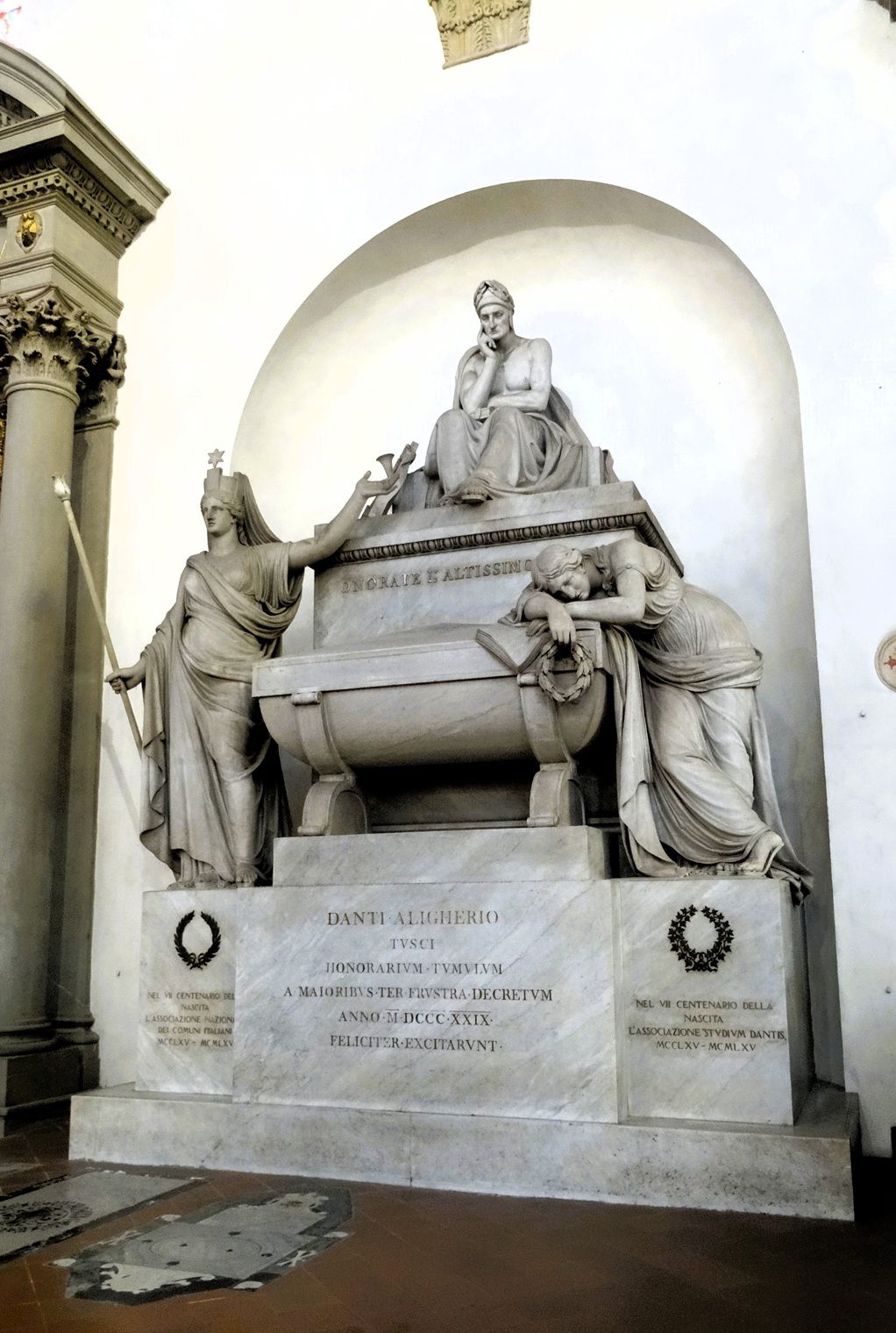
The Chapter House, known as the Pazzi Chapel, is located to the south of the nave and is accessible through the cloister area. Designed by Filippo Brunelleschi, the chapter house is a masterpiece of Renaissance architecture and serves as a serene space within the basilica. Its construction began in 1429 and was completed in the 1470s. Its harmonious proportions and use of geometric shapes reflect the ideals of the Renaissance. It is entered via an atrium with six Corinthian columns by a central arch. The room is covered by an umbrella-shaped dome, while the two sides are covered by a barrel vault roof.
The Basilica also has a chapel associated with the Medici family. It is known as the Medici Chapel of the Novices. This rectangular chapel, built between 1435 and 1445, was funded by Cosimo de' Medici, who became its patron. The chapel is dedicated to St. Cosmas and St. Damian, the Medici family's patron saints, and their images are featured in the stained-glass windows created around 1450. The chapel's Renaissance design is attributed to Michelozzo, a prominent architect of the time. Over the years, its furnishings have been altered, but it still retains its historical and artistic significance. Notable works include a glazed terracotta altarpiece by Andrea and Giovanni della Robbia, created around 1495, and other artworks that have been preserved despite changes over the centuries.
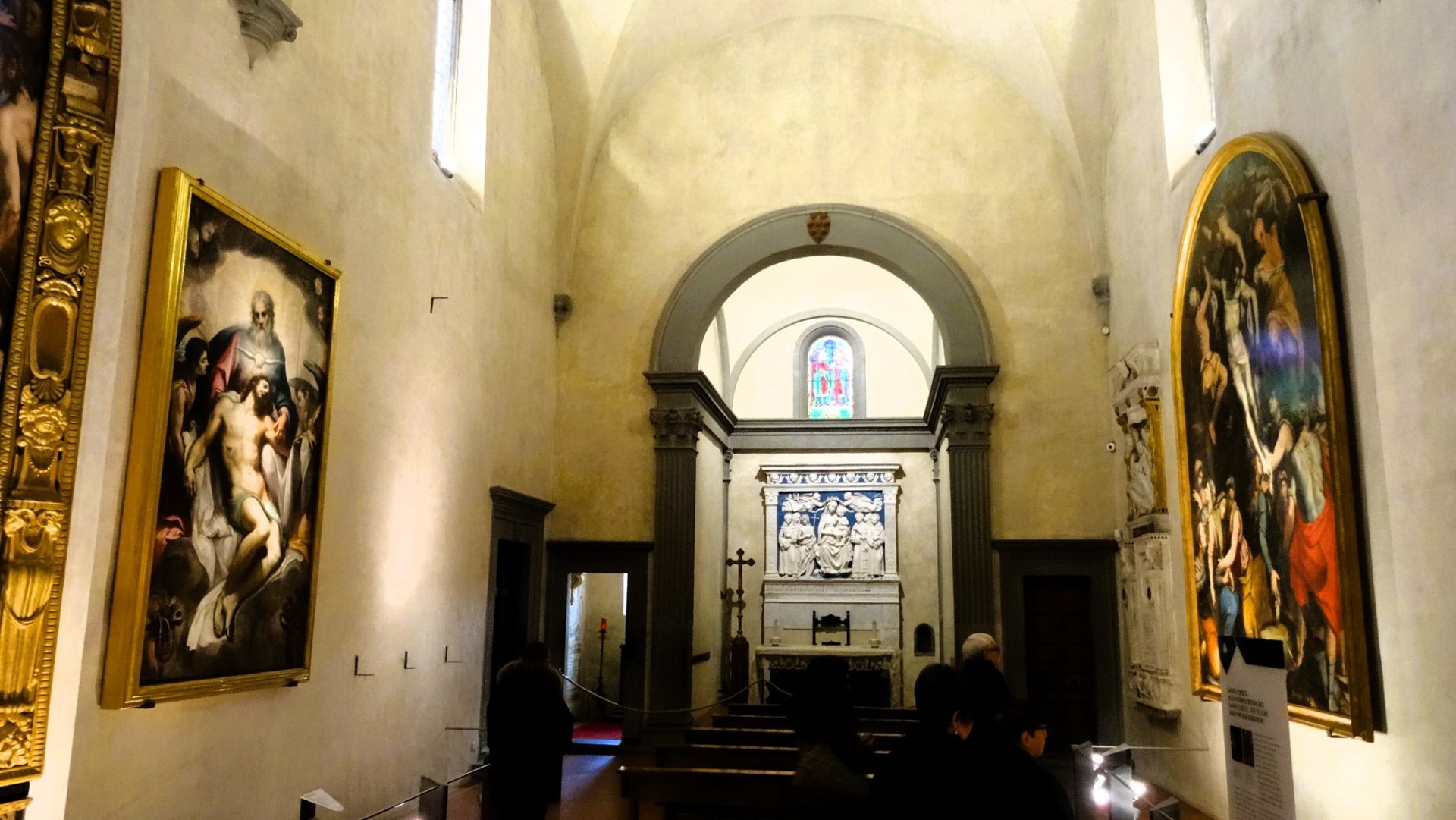
The Sacristy Corridor connects the church to the Medici Chapel and the novices' dormitory. Built between 1435 and 1445, it was funded by Cosimo de' Medici and likely designed by Michelozzo, showcasing his distinctive style. The corridor is adorned with white marble tomb slabs and a barrel-vaulted roof, with natural light streaming through three windows on the west wall. On the opposite wall, is the Monument to Lorenzo Bartolini, carved by Pasquale Romanelli in 1858. Since 2014, the corridor has housed masterpieces restored after the devastating flood of 1966. Notable works include Lorenzo di Niccolò's Coronation of the Virgin (early 15th century) and Neri di Bicci's Holy Trinity with Saints (1461).
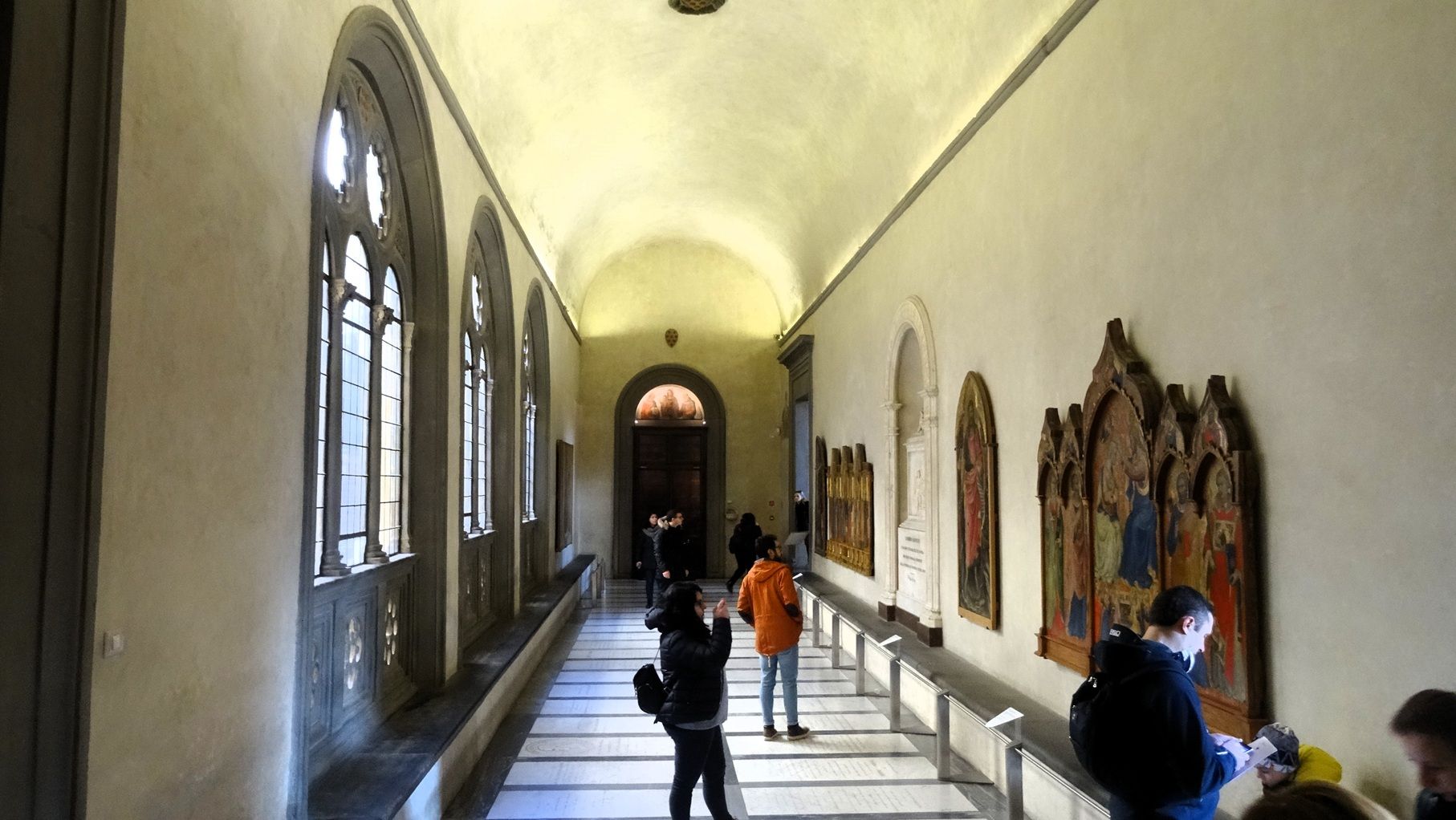
The sacristy is the room where the priests prepare for a service, and where vestments and articles of worship are kept. In Santa Croce it includes the Rinuccini Chapel which contains some well-preserved frescoes and original 14th-century furnishings and provides an indication of how the church would have looked in the 14th century when it was completely covered with paintings. The central wall is frescoed with scenes of the life of Christ. The wooden ceiling is decorated with Franciscan saints. Within the sacristy hangs a large wooden Crucifix which has become the symbol of the 1966 flood which damaged so much of the building and its artefacts, including the Crucifix.
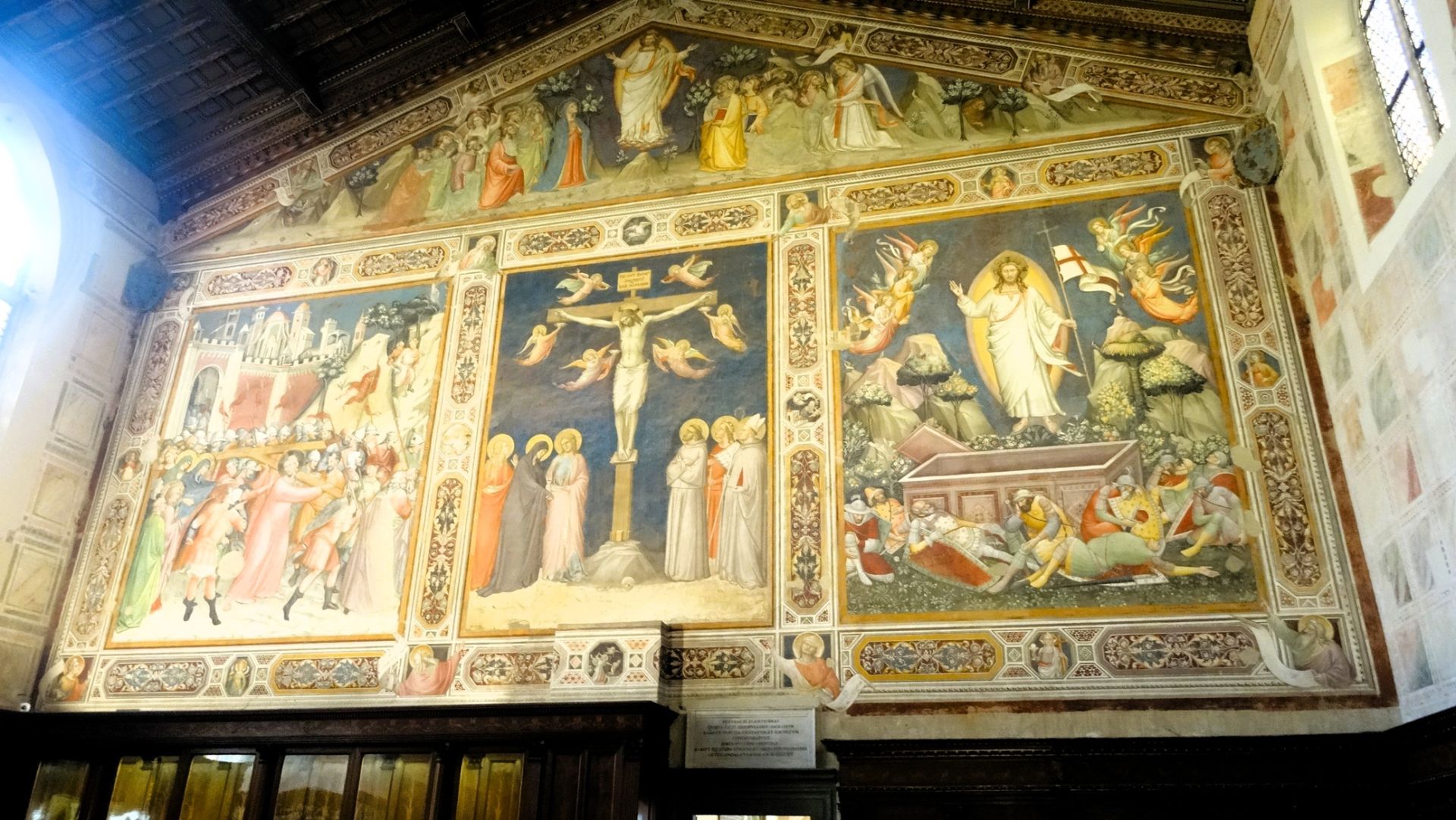
The church’s crypt was not discovered until 1844 after a flood in that year. It was used as a place for storage until the 1930’s when it became a war memorial. It was converted into a shrine in 1934 by Alfredo Lensi.
The complex of Santa Croce has three cloisters. These are covered walkways which provide a place for contemplation and meditation. The Ancient Cloister is located by the bell tower and contains tombs and cypress trees, which are the symbol of death. The Cloister of the Dead was built by Arnolfo di Cambio (1240-1302) and is known by that name because it held a number of tombs. Later, this cemetery was converted into a garden. The third cloister, the Primo Chiostro, was designed by Filippo Brunelleschi (1377-1446), who designed and built the dome of the Duomo in Florence. He never saw the cloister completed, as it was not finished until many years after his death. Within this cloister is a monument to Florence Nightingale, who was born in Florence and named after the city. Off this cloister is the refectory which houses the Museo dell'Opera di Santa Croce where religious artefacts and paintings are on display.

The campanile (bell tower) is in the cloister to the right of the church and stands over 78 meters high. This was built over a period of several hundred years. The original tower was over the apse of the church, but this fell down in 1512 and, although the replacement was started immediately, funding issues meant that it wasn’t completed until the 1800’s.
The campanile was rebuilt in 1847 by the architect Gaetano Baccani, who relocated it next to the sacristy, situated adjacent to the church although the current bell tower was built in the 19th century, it blends harmoniously with the church’s design. Its height and slender profile draw the eye upwards, emphasizing the Gothic style's focus on verticality.
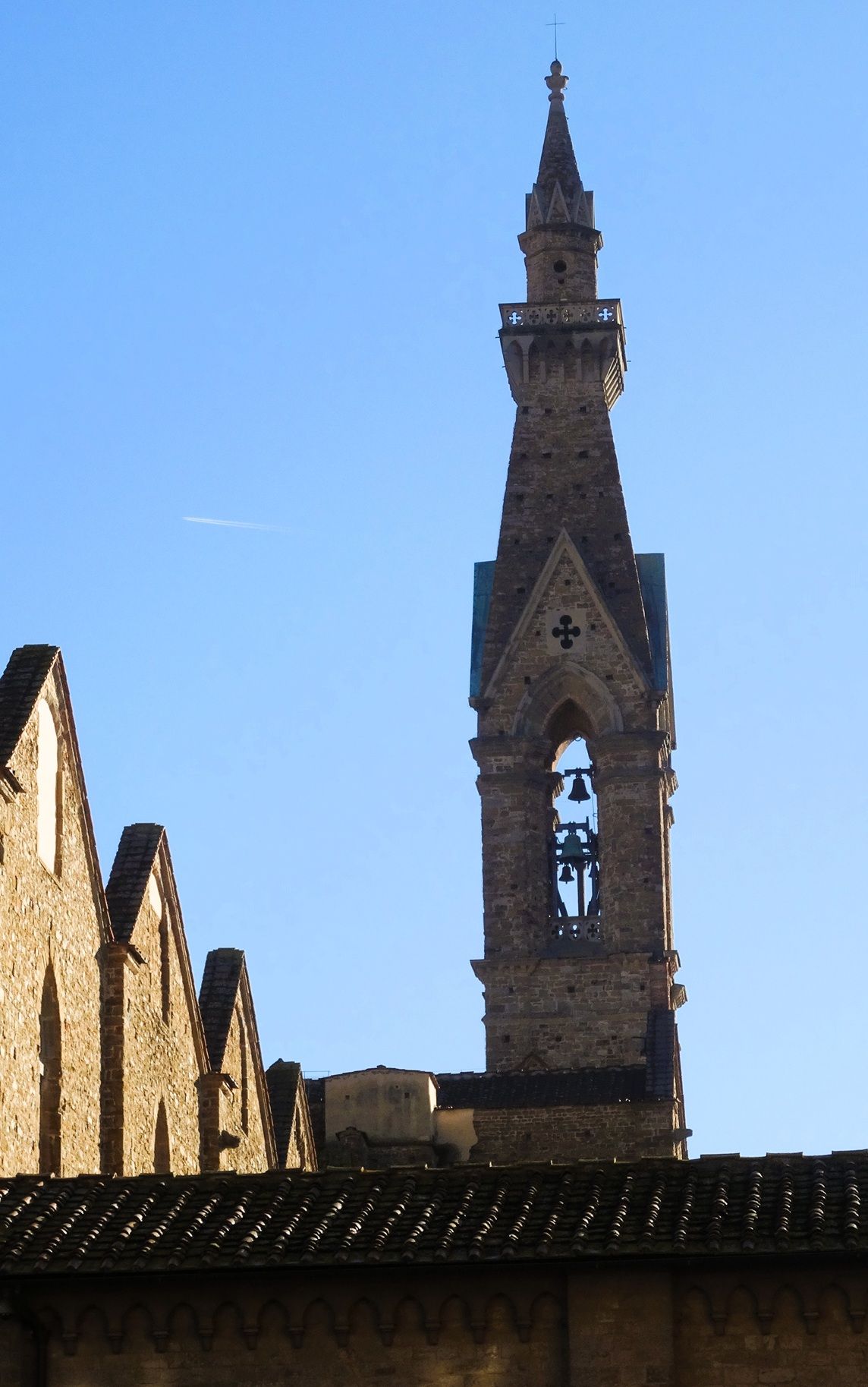
The Room of the Well is part of the 15th-century project commissioned by Cosimo de' Medici for the Novitiate area. This room was closely connected to the adjacent sacristy and originally housed liturgical vestments, accoutrements, a washbasin and a well, hence its name.
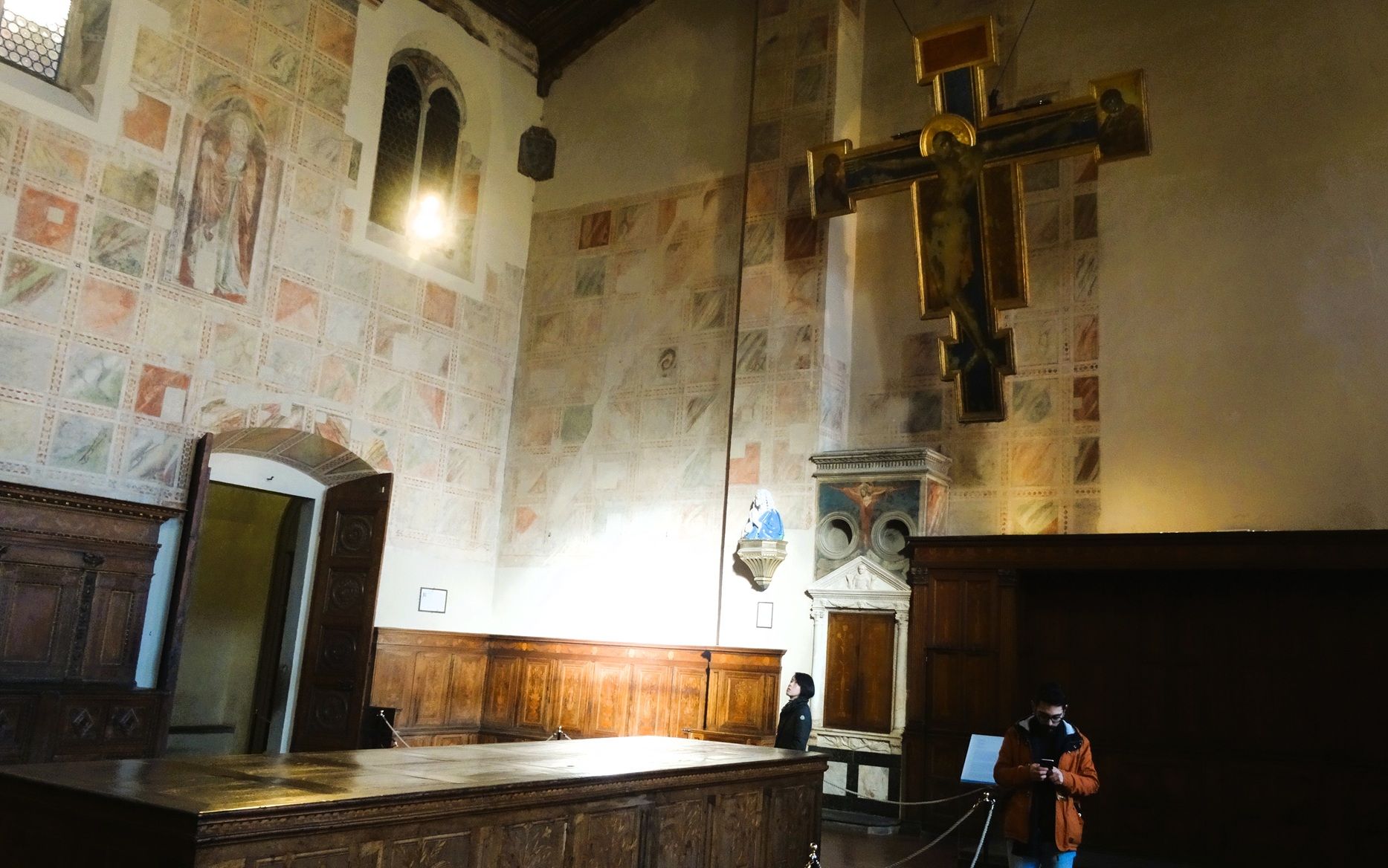
In 1866, following the wars that gained Italy its independence and unity, the government carried out the suppression of most religious complexes and Santa Croce became public property.
In 1933, the church was given the title of “Basilica” by Pope Pious XI. Today San Croce is the largest Franciscan church in the world.
In 1966, Santa Croce was flooded by the Arno River, as in fact was much of Florence. A great deal of damage was done to the buildings, when mud, pollution, and heating oil were brought into the structure causing a great deal of damage to the building and its treasures, damage that was to take several decades to repair.
Visit official website





